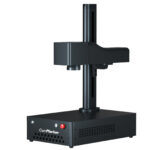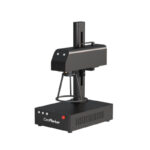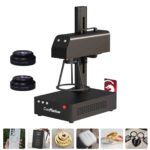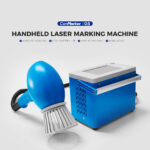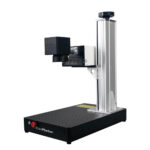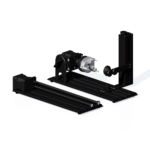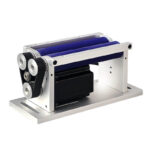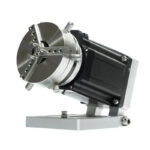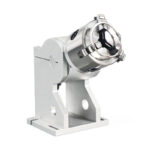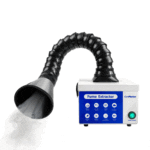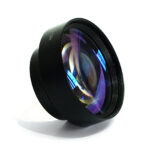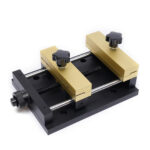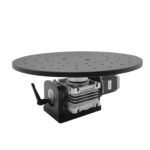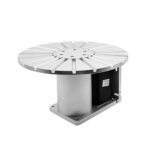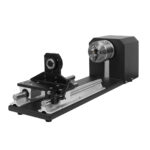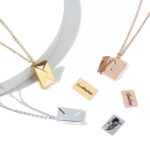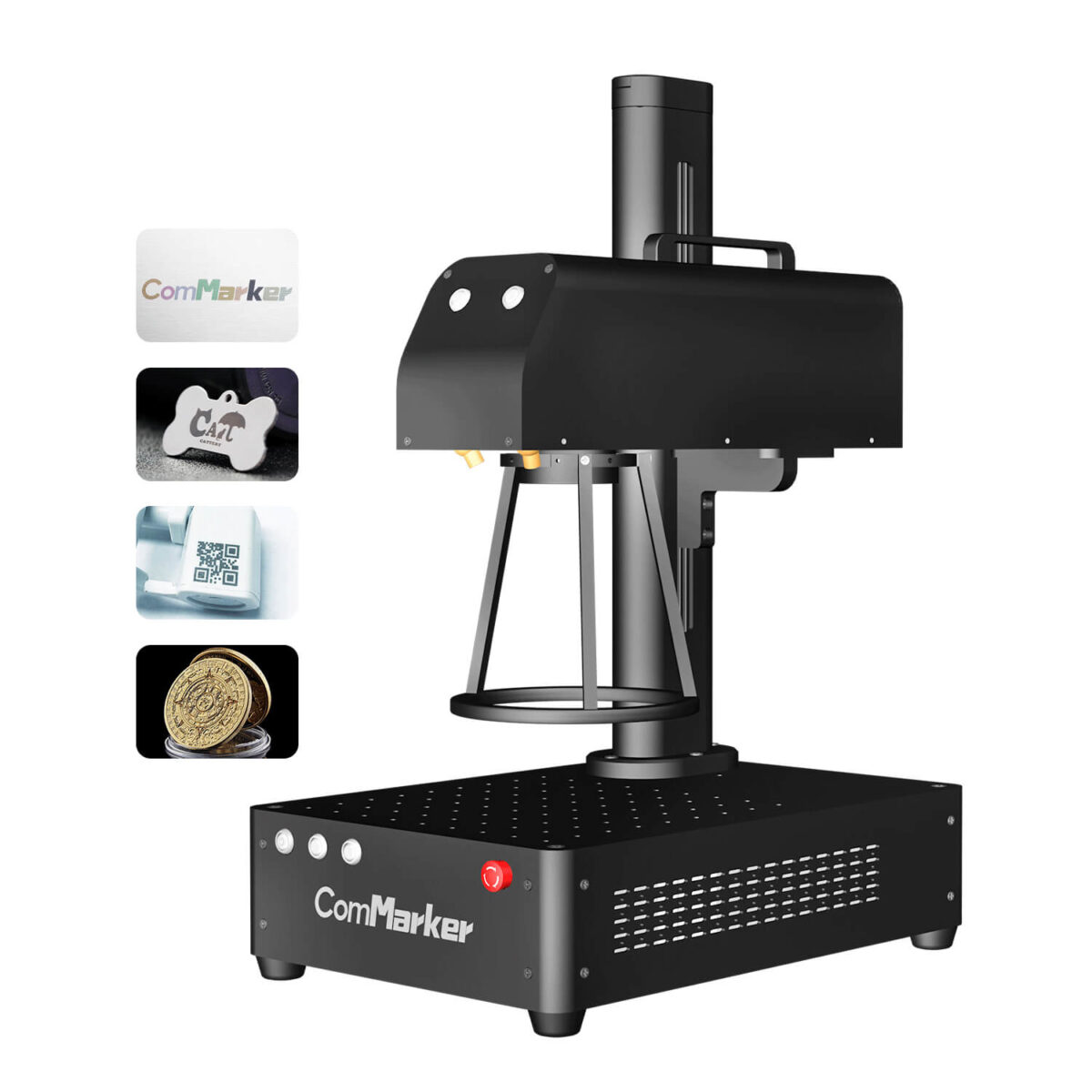B4 mopa 60W 레이저 마킹 머신의 크기
스피커, 그룹에게 연설하기, reflects on their experience from the previous year when they examined an early production prototype of a ComMarker B4 desktop 섬유 레이저 조각사. 프로토타입, 작은 20와트 모델 광섬유
A laser engraving machine featuring a Q-switched Max Photonics Source was considered a capable machine. 하지만, it met an unfortunate fate and was disassembled for entertainment purposes.
Now facing a new challenge, the speaker notes the arrival of a larger version, 그만큼 “bigger brother” of the B4 20W 레이저 조각사 model, also named ComMarker B4. This new iteration appears to be significantly heavier, with a purported 60-watt JPT MOPA 파이버 레이저 source. The speaker expresses curiosity about its capabilities and whether it can redeem the family name.
ComMarker B4 JPT MOPA 파이버 레이저 마킹 머신
ComMarker B4 -MOPA JPT MOPA 섬유는 스테인레스 스틸에 생생한 컬러 마킹을 가능하게 하고 양극 산화 알루미늄에 고대비 조각을 가능하게 합니다.. 아니다
Having primarily tested 레이저 조각 기계 ~와 함께 20 watts or lower power previously, the speaker acknowledges the significant increase in power and the potential benefits it brings in terms of speed and cutting depth. They speculate on potential applications for this increased power.
The speaker comments on the upgraded safety goggles provided with the new model and observes the considerable weight and size of the machine. They note that despite its bulk, the machine is efficiently designed, with all necessary components neatly integrated into the base plate assembly.
Assembly is straightforward, with just a few screws connecting the various components. The speaker appreciates the manufacturer’s openness to inspection, noting improvements in the assembly compared to the previous model.
In conclusion, the speaker expresses satisfaction with the machine’s assembly and readiness for use, only ten minutes after unpacking. They anticipate further exploration through teardown.
A preconfigured ezcad2 lite software copy is provided on a USB stick, instantly ready to use. It operates silently in standby mode, with fans only spinning up during longer, higher-power operations. The narrator reflects on past skepticism regarding the Z-axis power feed through a DC gearbox motor due to difficulties with the hand crank on the tall machine. 하지만, they now consider power feed justified, suggesting that a stepper motor could further enhance performance by automating deep 3D engraving operations.
The narrator discusses the machine’s large height, noting the need to account for the standard field lens with a 200 mm focal length. They highlight the potential for utilizing the machine’s height to expand the working area with an optional field lens featuring a 380 mm focal length. Despite the advantages of the tall machine, the narrator opts to continue using a smaller area lens for the time being to achieve the smallest focal point diameter.
추가적으로, the narrator mentions learning new techniques and optimizing scan speeds for efficient engraving. They acknowledge the manufacturer’s specification of a high scan speed of 10,000 mm/s and aim for a more manageable 7,000 밀리미터/초. The narrator shares the parameters for image engraving on coated or anodized metal parts, emphasizing the machine’s ability to produce stunning results.
뿐만 아니라, they discuss the advantages of using a powerful pulsed infrared laser for engraving various materials, including bare metals. The narrator proposes a method for achieving high-quality engraving on uncoated metals, highlighting the machine’s fine control over average power and impulse timing.
In conclusion, the narrator acknowledges the trial and error involved in finding optimal parameters for different materials and desired looks. They express the need for more resources on the internet regarding working parameters, particularly for color engraving on stainless steel.
Colored markings on Stainless Steel and titanium
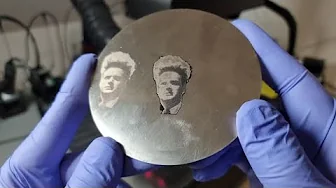
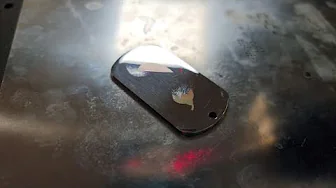
Among the headline features of the product, present significant challenges in achieving the desired outcome. The process involves thermally growing a surface oxide layer, the thickness of which determines the color effect. Even a slight difference in thickness, on the order of tens of nanometers, can result in drastic changes in apparent colors. 그러므로, every variable, including field lens substrate thickness, focal length, alloy variations, and ambient temperatures, must be carefully considered.
Despite the existence of material test grids available online, they may not be particularly helpful due to the numerous variables involved. Instead, systematic testing with a significant amount of material is often necessary to achieve the desired results. 하지만, for products with consistent properties, such as mass-produced items, investing time in perfecting the settings for the 컴마커 B4 레이저 조각기 may only be required once.
ComMarker B4 JPT MOPA 파이버 레이저 마킹 머신
ComMarker B4 -MOPA JPT MOPA 섬유는 스테인레스 스틸에 생생한 컬러 마킹을 가능하게 하고 양극 산화 알루미늄에 고대비 조각을 가능하게 합니다.. 아니다
For high-value, unique products like custom knives or artisan woodworking, finding optimal settings may take around an hour with some experimentation. The thin film interference responsible for the color effect theoretically allows for the creation of every color in the visible spectrum. 하지만, in practice, achieving certain colors, particularly pure red, can be challenging, with many shades tending towards brown or olive. 추가적으로, the appearance of colors can be viewing angle-dependent.
Nevertheless, the ability to create colored markings is both fascinating and immensely useful. Despite the challenges, the capability of the product continues to impress, promising further advancements in the future. Optional features may offer additional functionalities, enhancing the product’s versatility.
Rotary axis and Auxiliary Holder


The B4 fiber laser engraver offers users the option to include a rotary axis for an additional cost of $250, with a current $50 extra fee. This addition brings several advanced functionalities to the machine, enhancing its versatility and capabilities.
Included in the rotary axis package is an advanced JCZ controller card prepared with iOS, providing users with an additional motion axis for more complex engraving tasks. 추가적으로, an external stepper motor driver is provided, which conveniently plugs into the rear of the engraver. The physical third axis, essentially a chuck attached to a stepper motor, adds a new dimension to engraving possibilities.
Despite the potential advantages of the rotary axis, some users may find themselves not utilizing it frequently. 하지만, in certain contexts, such as jewelry engraving, the rotary axis can prove invaluable, allowing for personalized engravings on items like wedding rings and jewelry engraving.
An interesting feature included with the holder is a focusing aid, enabling users to add a fixed distance ring to the head for handheld operation. While this feature may not be utilized regularly, its presence adds to the machine’s versatility.
뿐만 아니라, the holder comes equipped with a convenient handle and a manual fire button on the head. These features, while impressive, also evoke a sense of caution due to their potential for complexity and the need for careful operation.
In conclusion, the rotary axis is an optional addition to the B4 fiber laser engraver that offers advanced functionalities and expanded engraving capabilities. While some users may not utilize it frequently, its presence adds value to the machine, particularly in specialized applications like jewelry engraving. 추가적으로, the included features such as the focusing aid, handle, and manual fire button further enhance the machine’s usability and flexibility.
ComMarker B4 Mopa-JPT M7 Laser source
Modifications have been made to the machine, with further considerations before pushing it to its limits. The thread grid plate still employs through holes, which are easy and inexpensive to manufacture. 하지만, when ablating metal parts, especially conductive dust, can fall through these holes and potentially enter the laser source through its cooling system or come into contact with the controller card or mains power supply. A plate with blind holes would be preferable, albeit more costly. An easy fix for this issue can be applied either by the manufacturer or by the customers themselves, as outlined in the manual for JP’s M7 fiber laser.
According to the manual, the bend diameter for the beam delivery cable must be at least 15 cm to prevent power loss in the fiber. The com marker team has taken note of this requirement and arranged the coil accordingly. 하지만, the section where it bends around the corner is too tight for the narrator’s preference, prompting them to reroute it slightly.
전반적인, the construction of the machine has improved compared to previous iterations, though it may not be considered world-class. 그럼에도 불구하고, considering the machine’s price point, which is only $500 more than a 20-watt more from a competitor while being three times as powerful nominally, it offers great value. 추가적으로, the machine’s laser power exceeds its average output power slightly, as verified by an OFIER L3C continuous wave power sensor.
The machine was delivered with a test certificate from one of the most reputable fiber laser source manufacturers in China, specifying an operating lifespan greater than 100,000 시간. Although it’s challenging to prove this claim, given that the M7 model hasn’t been around for 11 연령, since it’s a complete solid-state system, it instills confidence in its durability and longevity.
Laser protection
The narrator emphasizes the importance of safety when operating the machine, noting that it far exceeds the requirements for a class 4 레이저. They highlight the necessity of implementing numerous safety features to ensure safe operation by humans. 하지만, they mention that the ComMarker B4 섬유 레이저 기계 lacks significant safety features, allowing the manufacturer to offer it at a lower price than Western standards.
They caution viewers against operating the machine openly, suggesting instead that it should be treated as a component for building a safe machine oneself. Despite this warning, the narrator admits to taking risks by filming without a fully enclosed opaque box to capture more visually interesting footage.
To mitigate some risk, the manufacturer has included a freestanding orange acrylic shield and a pair of safety goggles, which are of higher quality than typical green plastic ones. 하지만, the narrator expresses reservations about the reliability of these safety accessories, as they lack visible markings or manufacturing information.
While acknowledging that both the shield and the goggles provide some level of infrared attenuation, the narrator remains cautious, particularly regarding the goggles’ effectiveness without a well-known brand name. Despite these concerns, the narrator proceeds with their experimentation, noting one additional observation about the machine’s performance.
Pulse width measurement
The narrator discusses an opportunity for improvement concerning pulse width measurement in the B4 machine, focusing on its head and Galvo scanner. They note that the only audible component in standby mode is the red preview laser pointer, which they couldn’t disable. 일반적으로, disabling the red pointer is possible with a JPT M7 source, enabling cleaner readings with a photodiode. 하지만, the B4 employs an external additional laser diode and a dichroic beam combiner, unlike the JPT M7 source.
The advantage of this setup is that the red pointer remains on continuously, whereas the JPT pointer is mutually exclusive with the power output. Despite this advantage, the narrator plans to remove the setup due to a microscopic offset between the preview point and the actual working beam, which may affect measurements.
To address pulse widths in the nanosecond and below range, the narrator attempts to use a $50 indium gallium arsenide photodiode with a sub-nanosecond rise time. 하지만, they encounter difficulties in building a trans-impedance amplifier for accurate measurements due to the need for gigahertz PCB designs and specific components.
Instead, they opt for reverse biasing the photodiode with batteries and digitizing the current impulses through a 50-ohm resistor and coaxial cable to the scope. While this setup is adequate for confirming pulse widths in the sub-nanosecond range, it lacks the finesse required to observe peak output power waveforms.
Despite the challenges, the narrator remains determined to continue experimenting with the machine, noting that they will focus on more enjoyable activities now that the initial work is complete.
Fiber Laser Marking machine – Material Testing
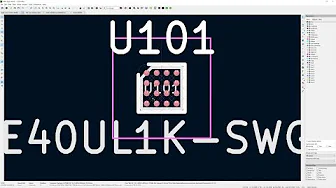

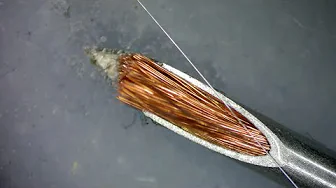
In the realm of Cu sheet cutting, the narrator expresses enthusiasm for the revolutionary capabilities of the machine in their lab. They anticipate releasing videos to their Patreon and channel members to showcase the purpose of copper shims. 추가적으로, they discuss their plans for wire welding, aiming to construct a resistance standard from a nickel-chromium alloy wire. 하지만, they encounter challenges due to the thinness of the wire, leading to difficulties in spot welding.
Moving on to plastic welding, the narrator experiments with welding thicker materials using the pulsed laser function of the JPT M7 source. Despite initial skepticism, they achieve satisfactory results after a few attempts. 하지만, they opted not to pursue further experiments due to the unpleasant odor associated with plastic welding.
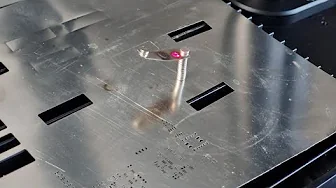
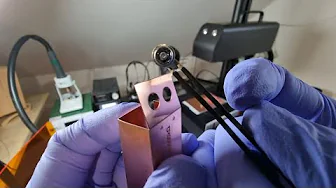
Transitioning to stainless spot welding, the narrator demonstrates successful spot welding on stainless steel sheets. Despite encountering initial challenges, they achieve strong welds, highlighting the ease of the process.
Continuing their exploration, the narrator delves into intermetallic welding, attempting to solderable pins in a blue glass seal. They employ a pulsed operation with kilowatt power bursts to weld copper, 은, 금, and steel. Although the results are not flawless, they acknowledge the mechanical strength of the welds achieved in their third attempt.
Thanks again to Marco Reps for sharing with us his experience and guidance on the ComMarker B4 jpt mopa 60w 레이저 마킹 머신. https://www.youtube.com/watch?v=D-sTbr1ZuEU

